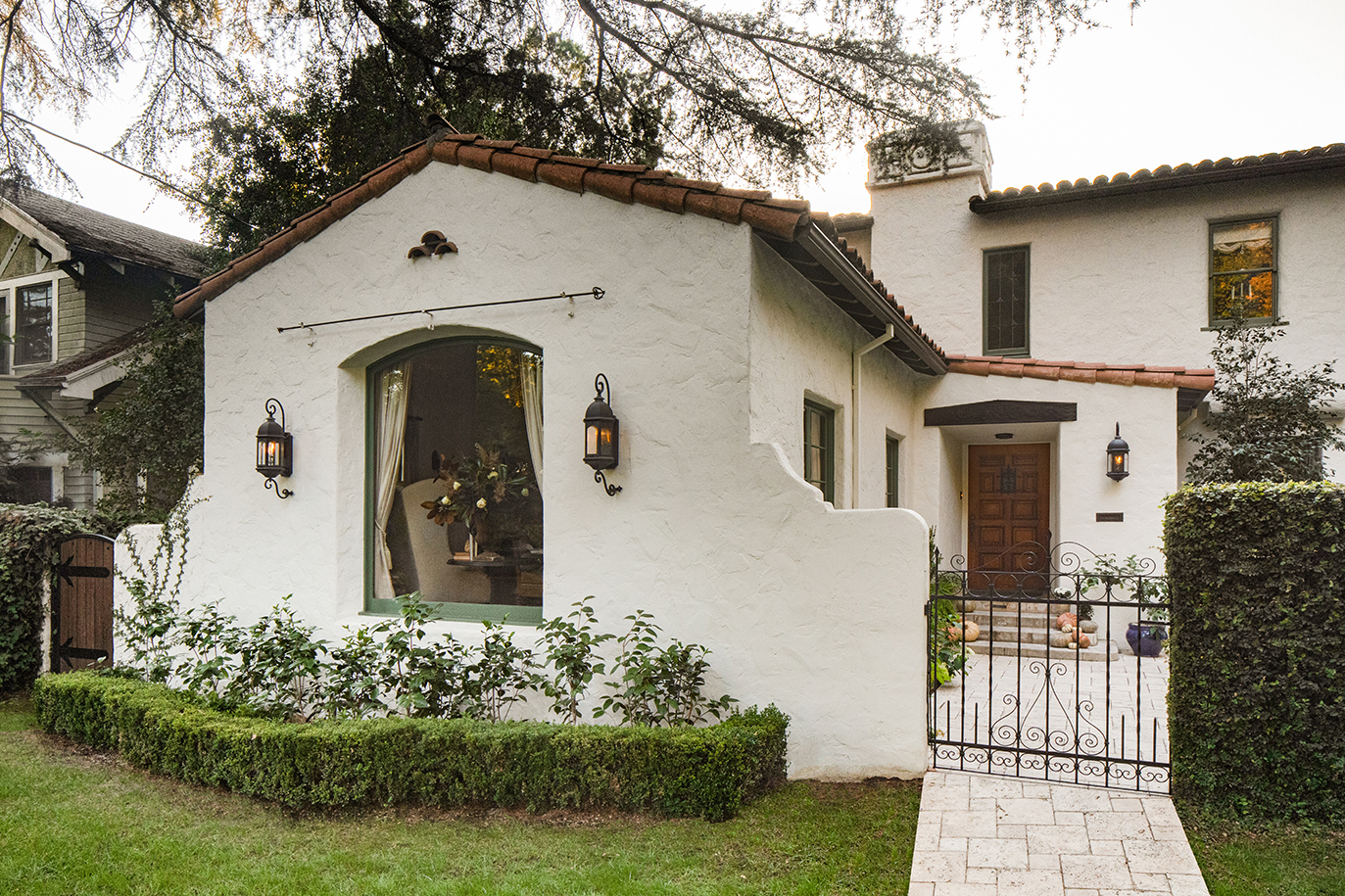Preserving the Past, Crafting the Future: A Guide to Spanish Style Home Remodeling with HartmanBaldwin
Spanish-style architecture exploded in popularity in the early 20th century. The casual asymmetry and indoor/outdoor connections reflected the culture’s move toward informality. It was also perfectly suited to the climate of the developing Southern California region, and, maybe most importantly, it reflected both a romanticized past and the very current romantic allure of Hollywood. Join us as we explore the defining characteristics that make these homes so special, delve into the importance of preserving their original architectural details, and how a design-build firm like HartmanBaldwin can customize the floor plan or make other alterations to serve your needs better while honoring its style.
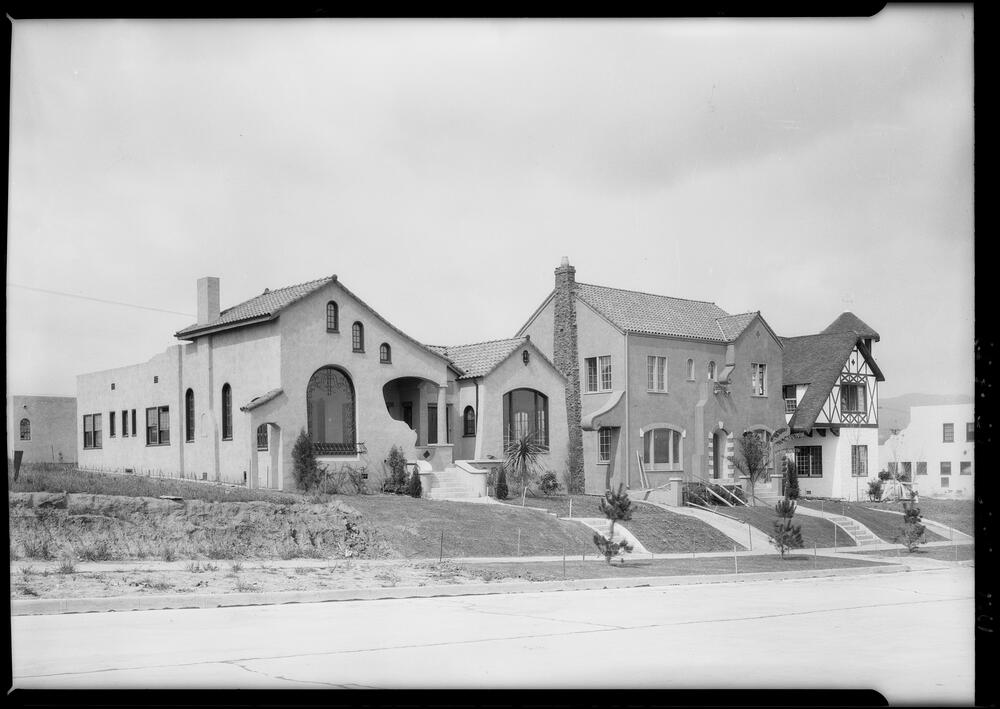
Spanish-style homes are immediately recognizable for their distinctive look, often characterized by red-tiled roofs, white-washed stucco walls, and wrought-iron detailing. What we call “Spanish Style,” is more accurately referred to as “Spanish Colonial Revival.” After World War I, revival styles in domestic architecture became incredibly popular. Today you can find older neighborhoods filled with Tudor, Normandy, Colonial, and Cape Cod homes – often side-by-side. But none of the revival styles were as ubiquitous in California as the Spanish Revival. Early architects working in the style drew inspiration from Spain and the southland’s Spanish and Mexican heritage. As rich as that heritage was, there were very few existing homes to draw inspiration from, and those that did exist were often ramshackle or very humble. So, in addition to studying the old adobe casas and ranchos, architects also looked to presidios and mission architecture for inspiration.
This makes sense when you start considering some common elements of the style like courtyards, fountains, arched arcades, and stained-glass windows. As diverse as the style is, preserving the distinctive architectural details is crucial to maintaining the authenticity and charm of the design. So, let’s look at some key features that define the Spanish Colonial Revival Style and why they are important to preserve.
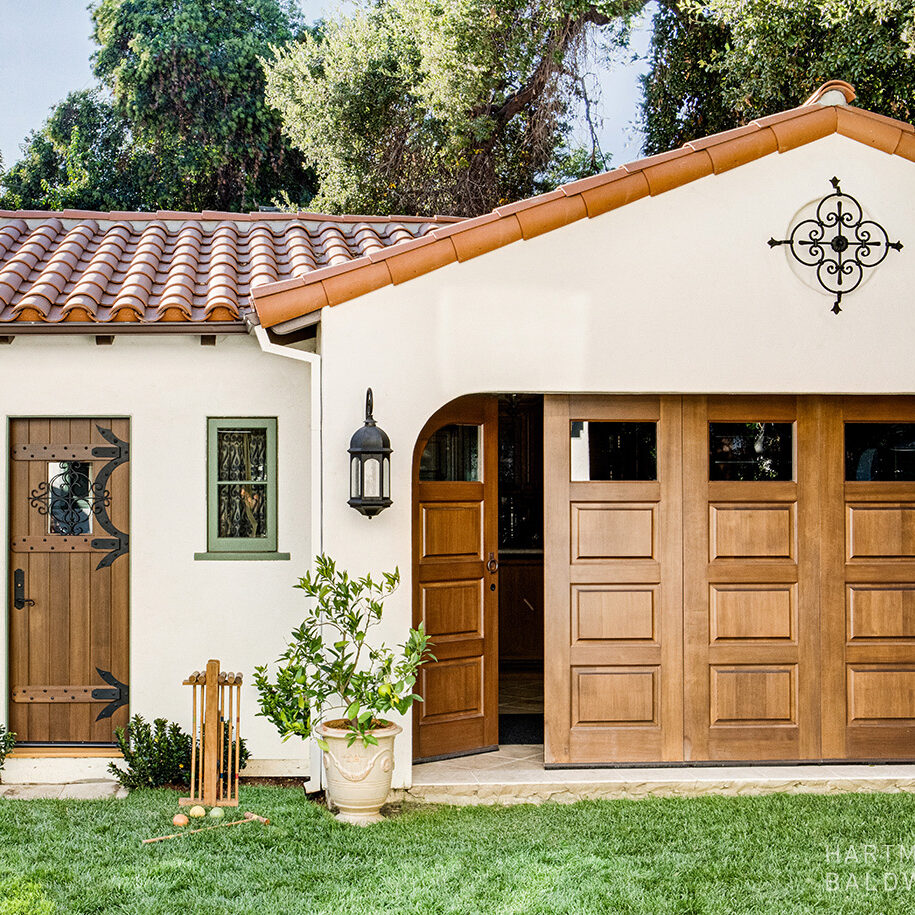
Red-Tiled Roofs
The iconic, red-tiled roofs, inspired by Spanish and Mediterranean influences, are a defining feature of Spanish-style homes. They not only contribute to the aesthetic appeal but also reflect the historical connection to Spanish and Moorish architecture. Smooth but hand-troweled and slightly irregular stucco finishes for the exterior walls, often in tones of creams to light earth tones, create a cohesive and textured appearance that provides a durable and weather-resistant exterior while paying homage to the traditional building materials of Spanish architecture.
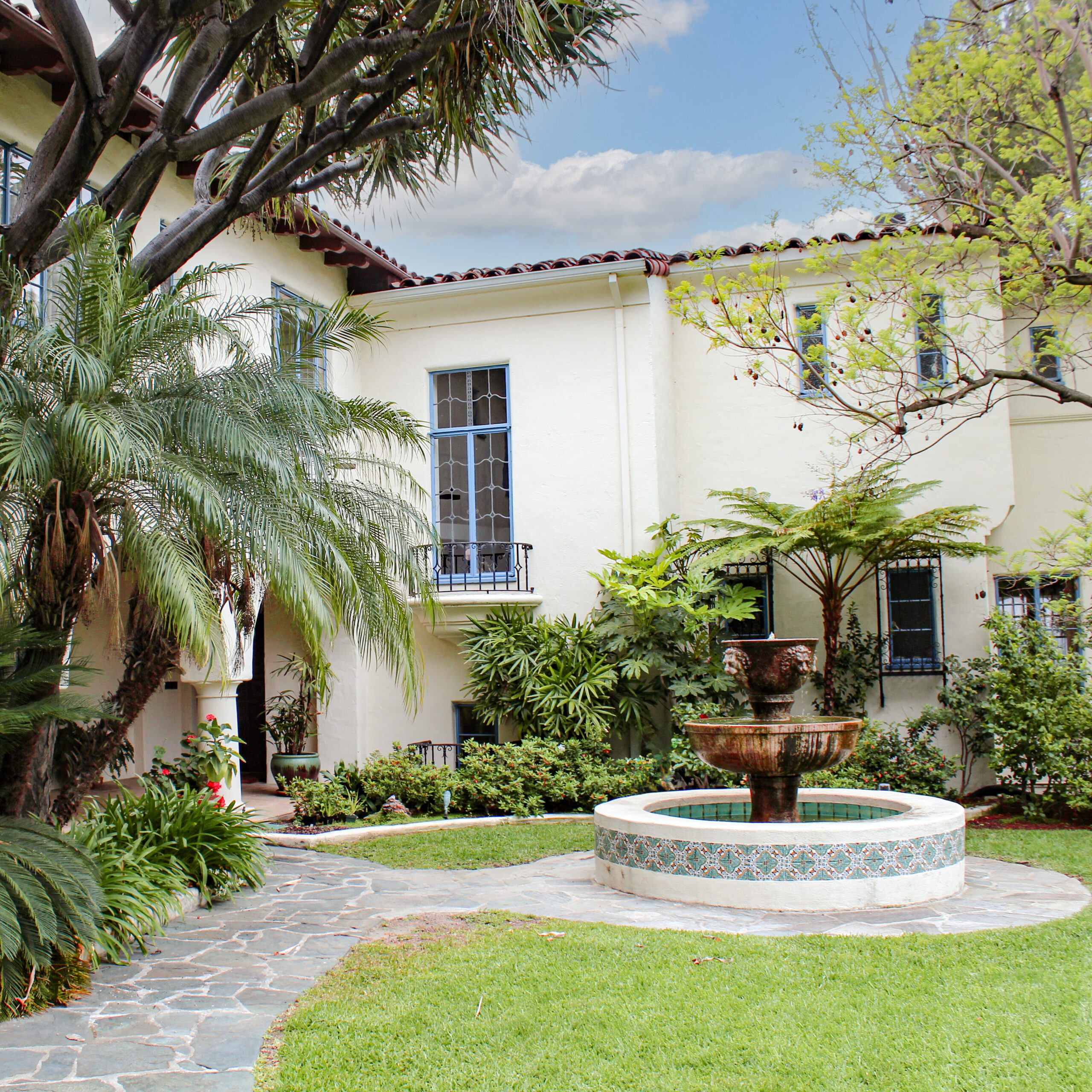
Courtyards
& Outdoor Living
You could say that our mild climate liberated the living spaces from their interior boundaries. Spanish-style homes often embrace the concept of outdoor living, with charming courtyards and patios that seamlessly blend the boundaries between indoor and outdoor spaces. Low garden walls, built-in benches, or even plantings may define these spaces. They are sometimes under a roof, covered with a trellis or pergola, or completely open to the sky. They may be behind or to the side of the home but can also often be found as entry courtyards. The asymmetric plans of many Spanish homes are designed to look as if they grew almost organically, and courtyards fit into this wonderfully. They are perfect for entertaining guests, enjoying a cup of coffee in the morning sun, or simply basking in the beauty of your private oasis. Courtyards reflect the Mediterranean tradition of creating private, inviting retreats for communal enjoyment. Preserving these spaces enhances the overall lifestyle experience and connects modern homes to historical precedents.

Arches
One of the defining features you’ll notice is the prevalence of graceful arches. Arches are not just architectural elements; they are an integral part of the Spanish structural composition. Though Spanish-revival buildings are nearly always wood-framed structures, remember that the historical precedents were almost exclusively masonry structures – adobe, stone, or brick. In a masonry building, the arch is an important structural element necessary to distribute weight and allow for large openings. The graceful arches of the style harken back to this purpose. They frame doorways, windows, and even courtyard entrances, adding a touch of elegance and a nod to the influences that inspired this style.
Along with arches, you often find thickened walls and notice that the windows that are not arched, are relatively small. This, again, is a reflection of the style’s masonry precedent and origins. Though structurally, the arches and thickened walls are not necessary in wood-framed buildings, they are a critical element of the architecture and need to be preserved. If you are thinking of adding a large opening from the home to the backyard, for example, think of how arches may be used to integrate this new feature into the composition. Proportion is important. Notice that if there are a series of arches on a façade, there is a cadence to their placement. When making modifications, it is extremely important to consider proportion and feasibility. For the arch to be “feasible” it needs to look like it supports something and works with the overall composition.

Talavera Tiles
& Wrought Iron
Keep an eye out for the intricate details that make Spanish-style homes truly special. Talavera tiles, with their vibrant colors and geometric patterns, often add a touch of artistry to kitchens and bathrooms. Additionally, wrought-iron fixtures, gates, and railings are commonly found throughout the home, providing both functionality and a touch of Old-World charm that celebrate the artisanal traditions of Spanish blacksmiths which contribute to the overall visual richness and authenticity of the design. This contributes to the overall visual richness and authenticity of the design. In an unenlightened remodel, often the first thing to go is the original, handwrought fixtures and hardware – only to be replaced by mass-manufactured and poorly designed modern ones. Details like tiles and ironwork are the home’s equivalent of jewelry on a person – a good choice brings everything together, but the wrong choice can easily break the entire composition.
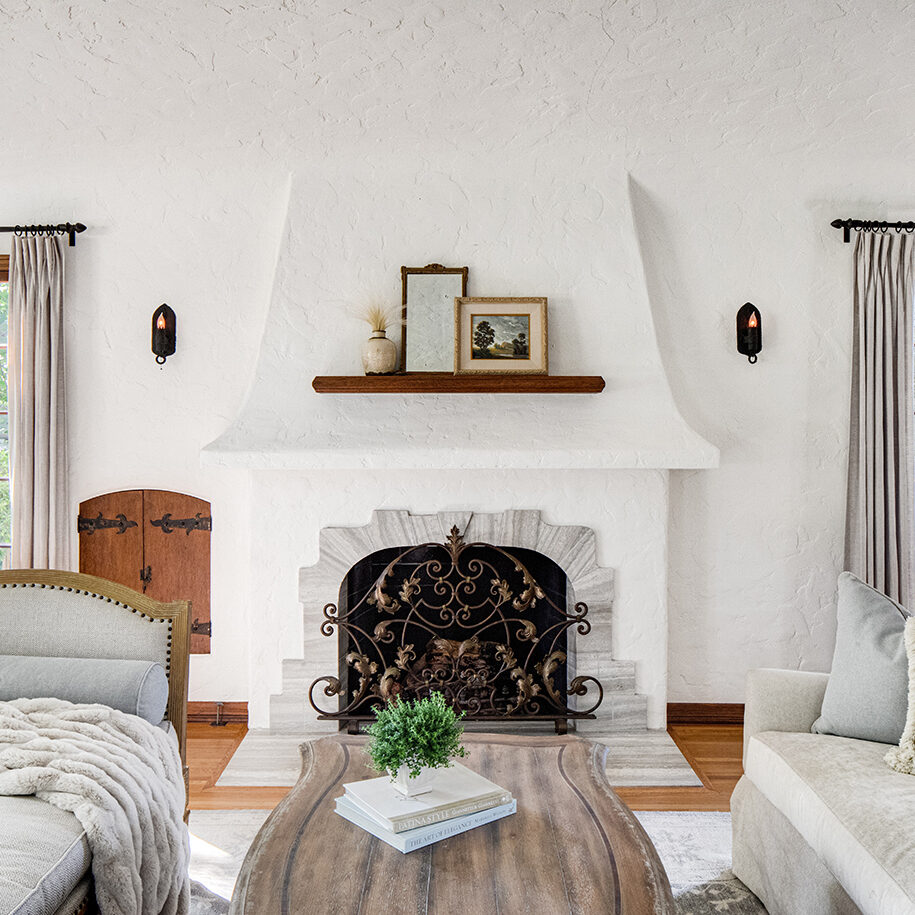
Earth-Toned
Color Palettes
When it comes to color palettes, Spanish-style homes favor soft whites and light earth tones for the body of the home and earth tones such as terracotta, ochre, and green for the trim and other details. In the Spanish colonial frontier – when the historical presidents were being built – natural pigments were simply all that was available. These colors reflect the natural surroundings and contribute to the cozy and timeless atmosphere. Wood accents, often dark-stained or aged in ceiling beams or furniture, add warmth and a rustic touch to the interior spaces. There is something truly striking about natural wood or stenciled beams against a white plaster ceiling. Interior trim is often minimal. In many examples, the plaster simply dies into the door or window jamb. This minimalist aesthetic resonates with our contemporary eye and is particularly striking when the doors or windows are natural wood. Back outside, the choice of appropriate exterior paint colors is very important. Don’t make the mistake of blindly following current trends.
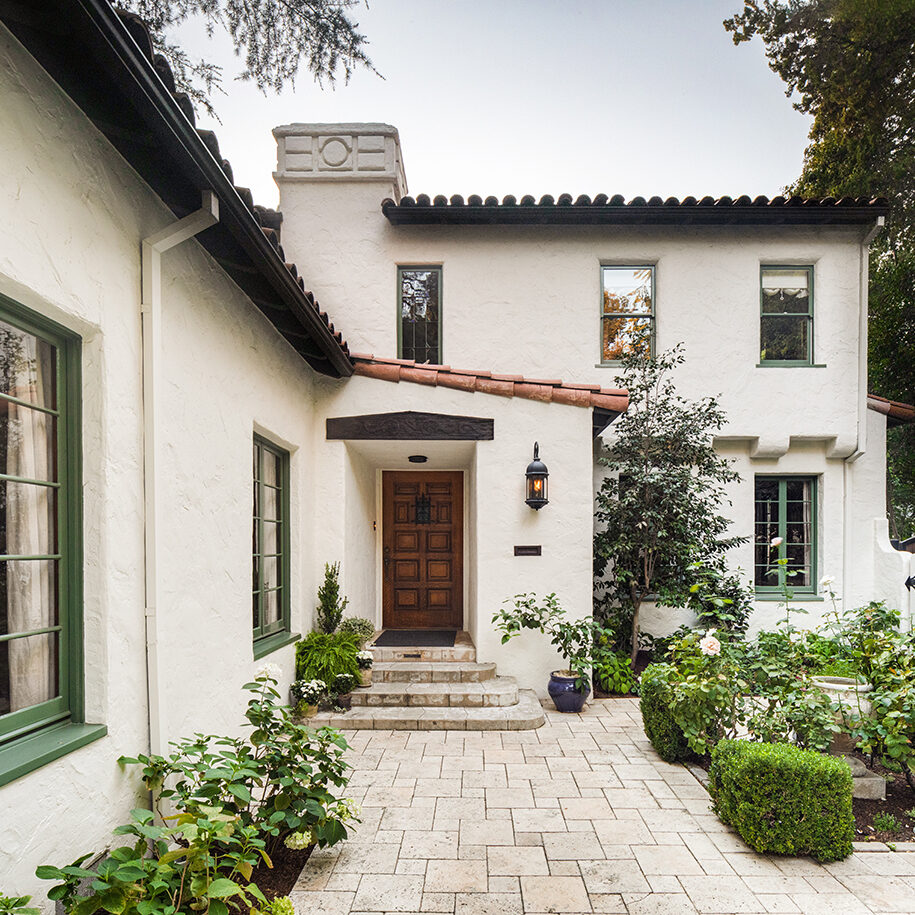
Fenestration
The graceful Spanish Revival façade is a composition of large arched openings and smaller windows. The style often employs a mix of window types, including wood or metal casement windows and even stained glass. The relatively small windows are an adaptation to the warm climate and again, a reflection of the masonry precedent. An attractive façade has windows placed in a manner that reinforces, rather than competes with, the design intent of the building. Because Spanish homes are asymmetrical and composed of distinct masses under different roof forms, the windows are placed to establish a rhythm of openings across the façade and to balance the solid parts of the walls. Sometimes, houses that would otherwise be beautiful lose their appeal because of the misguided selection of shiny plastic replacement windows, or in the case of a remodel, the windows’ awkward placement. Maintaining or restoring the original wood or metal windows is ideal. It’s often the most economical option and, contrary to popular opinion, a renovated and properly functioning historic window is compatible with current energy-efficiency standards. Sometimes the original windows have already been replaced with an inferior vinyl or aluminum product. It may also be the case that the original windows are determined to be beyond repair. You also may be adding or remodeling an exterior wall. In these cases, the new windows should be a quality product in a similar material to the originals. They should also possess the same proportions and have the same divided-light configuration as those they are replacing or to others in the home.

Preserving these architectural details is crucial to fully honor the original intent of Spanish Colonial Revival style homes. It not only pays homage to the historical roots of the design but also contributes to the overall sense of place and cultural identity. By retaining these features, we ensure that the essence of this architecture endures, creating homes that are not only aesthetically pleasing but also deeply connected to its local cultural heritage. Now, you might be wondering, ‘How do I navigate the remodeling process without losing the essence of my Spanish-style home?’ That’s where HartmanBaldwin comes in. With nearly 40 years of design-build experience, we specialize in preserving the integrity of historical homes while seamlessly integrating modern features. Our approach is all about preserving the soul of the home. We work closely with homeowners to understand their vision while respecting the architectural style. Whether it’s completely reconfiguring a floor plan or renovating the entire property to incorporate modern technology, our goal is to create a harmonious blend of old and new. A successful remodel should meet your needs and honor the original design.
And there you have it— a glimpse into the enchanting world of Spanish-style homes. Whether you’re a homeowner looking to infuse some character into your space or an admirer of architectural beauty, the Spanish Colonial Revival Style offers a timeless and inviting aesthetic that exemplifies the blend of Old and New World craftsmanship of our region. Remember that preserving the character of your Spanish-style home is not just about architecture—it’s about honoring the stories embedded in its walls. And with a design-build firm like HartmanBaldwin, you can confidently embark on a remodeling journey that respects the past while crafting a future designed to enhance your modern lifestyle. To see more examples, take a look at our YouTube Channel:
- Source: University of Southern California Libraries and California Historical Society. Digitally reproduced by the USC Digital Library. ↩︎

